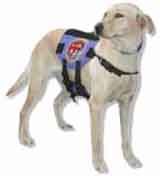Dog Behavior Problems and TrainingHelping A Battered Dog |
|
|
A dog that has been over-punished lacks self-confidence. Therefore, such dogs should be allowed to succeed. This is fortunately a simple process with dogs. They are dramatically quick to learn from people when taught by nonphysical methods. Even a simple 3-part exercise, performed daily, can bring about a behavior change in a few days. All that is needed is to crouch down, say "Rover, come," and heartily praise when it responds, even if it only looks at the owner. If the pet urinates on the way, the praise must be continued. The wetting usually disappears as confidence improves. When the dog comes all the way, it should be petted, preferably on the throat and chest to eliminate fear responses that may be caused by hands over or on top of its head. Most shy dogs usually come readily to a crouching figure. The "Sit" command is simple, once the pet comes dependably. A hand is held up over the dog's rump as the words "Rover, sit" are spoken. The dog usually looks upward, and should be praised by happily saying "Good, sit," but without bending down or petting. If this is patiently repeated a few times, most dogs will sit down. The spoken praise should be followed by petting. It is important not to bend over from the waist to pet shy dogs, as this movement often signals possible punishment. Crouching avoids bending over, and is friendly and reassuring. Pushing down on its rump, holding, or otherwise manipulating the pet must be avoided. Physical force is at the root of most submissive behavior and interferes with effective learning. The second part of therapy requires that owners avoid punishing the pet. If other behavior problems exist, these must be resolved using nonphysical methods and as light as possible. Self-control is a major challenge to most dog owners; however, after they see the progress usually achieved in a few days, their feelings that the pet "needs to be told it has done wrong" usually crop up. Any backsliding on the owner's part is quickly reflected by regression in the dog. This feedback provides an effective control mechanism to which most owners are highly sensitive. A third step in correction is used for dogs that respond submissively to persons outside the family. If a few friends are gathered to reinforce the owner's teachings, the dog usually responds satisfactorily. Correction in most cases requires only a few minutes on 2 or 3 occasions. Older dogs with a persistent problem may require longer training periods. This approach to correct overly submissive behavior in shy dogs assumes the pet is healthy, so that no possible organic influence interferes with the learning capabilities of the animal. Total rehabilitation can be expected in 6 weeks when the process is carried out daily. Back to the Dog Behavior Problems and Training page
| |
|
Related News About Dogs ' ); // get rid of newsfeed display by carp CarpConf('poweredby',''); CarpCacheShow('http://dogguidance.com/dogblog/?feed=rss2'); ?>
|
|
|
|
|
|
Copyright © 2006-2007 dogguidance.com |


